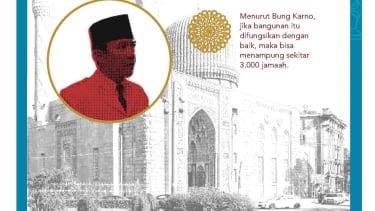5 Facts About the Relation Between Soekarno and the Soviet Union
- Twitter Kedubes Rusia di Jakarta
VIVA – For most people living in the New Order era, the Soviet Union was considered a communist country, even though under the leadership of President Soekarno at that time, the Soviet Union and Indonesia had a very warm relationship. In various historical records, this evidence is contained in some events. Here are some facts about the relationship between President Soekarno and the Soviet Union:
1. Diplomacy of Indonesia and the Soviet Union
Presiden Soekarno.
After independence, the Minister of Foreign Affairs of the Republic of Indonesia Mohammad Hatta received a message from the Soviet Union, through the Minister of Foreign Affairs of the Soviet Union, Andrei Vyshinsky the message indicated that his party had recognized Indonesian sovereignty or independence on December 27, 1949 in The Hague.
However, if you want to look back, the relationship between the two has been initiated since 1947, at that time through a young communist figure named Suripno, Indonesia was eyeing the sovereignty of the superpower of the Soviet Union, only that the desire was kept secret in quotes in order to respect the feelings of the United States which acted as a facilitator of the Renville Agreement.
There are two opinions on the authority given to the Indonesian communist leader, namely Suripno, to establish relations with the Soviet Union government.
The first authority came from the Minister of Foreign Affairs, Agus Salim to appoint him as the representative of Indonesia in Eastern Europe, while the second was directly appointed by President Soekarno as the official representative of Indonesia to attend the world youth congress.
2. Friendship with Nikita Khrushchev
Nikita Khrushchev (kiri)
- Wikimedia Commons / Bundesarchiv, Bild 183-B0116-0010-043 / Sturm, Horst / CC-BY-SA
The relationship between the two is said to have been established when Nikita Khrushchev was still the leader of the Communist Party of the Soviet Union, from that closeness, Indonesia benefited from the military aspect, aid continued to flow continuously from the Soviet Union to Indonesia and what is most remembered is that Indonesia finally had a plane. The first president was Dolok Martibnag of the Soviet Union.
In addition, the two leaders visited each other, starting with Soekarno who came to the Soviet Union in 1956, then Nikita Khrushchev came to Indonesia in 1960, the two-week visit will go down in history as a meeting of leaders of the superpowers.
Seven years after Nikita Khrushchev's visit, Sukarno was removed from office as Indonesia's first President, the anti-communist Suharto, severing friendly and diplomatic relations with the Soviet Union. Decades later in the early 1990s the relationship was restored after the Soviet Union's Communist regime was overthrown.
3. Soekarno and Blue Mosque in Russia
Masjid Biru yang kini dikenal dengan sebutan Masjid Bung Karno. Aktif kembali setelah dalam kunjungan Soekarno ke Rusia (Uni Soviet) meminta agar bangunan yang sempat dijadikan gudang itu diaktifkan kembali sebagai masjid (infografis/bungkarno.id)
- U-Report
Currently, the Blue Mosque in the City of Saint Petersburg is quite popular in Russia as a tourist destination. Previously it was difficult to build a mosque there, until Tsar Nicholas II the ruler at that time gave permission, precisely in 1907 the mosque builder was given as a tribute to the contributions of Muslim citizens who helped build the city of Saint Petersburg and when the mosque was built in 1910.
When the Soviet Union's communist regime came to power, almost all places of worship and religion were closed and then converted to function. Specifically, the Blue Mosque was closed in 1940 and converted into a medical warehouse.
The relationship between the blue mosque and Soekarno is that President Soekarno once asked for permission from Nikita Khrushchev so that the blue mosque could be used again as a place of worship for Muslims.
But unexpectedly, Nikita Khrushchev, who is anti-religious, complied with Soekarno's wishes, therefore Russian Muslims are very grateful to Soekarno, following Soekarno's nickname became popular after that.
4. Wholesale Defense Equipment from the Soviet Union
VIVA Militer: Presiden Soekarno di depan pasukan Indonesia
- kwiknews.my
The era of closeness between Soekarno and the Soviet Union was marked by the purchase of weapons by the Indonesian government. Precisely in the 1960s, the Indonesian government purchased weapons on a large scale specifically to support the operation to liberate West Irian or Papua.
However, after the agreement was executed, President Soekarno was overthrown and replaced by Suharto, who preferred to buy weapons from the Western bloc or better known as the United States.
5. Soviet Union Denies Freeing West Irian
Demo di era Soekarno pada tahun 1952
- Quora
President Soekarno and the leader of the Soviet Union, Nikita Khrushchev had one thing in common, namely supporting anti-colonialism in Asia and Africa, therefore when Soekarno asked for assistance in the liberation of West Irian, the Soviet Union quickly announced its support for Indonesia.
Initially Soekarno wanted to negotiate with the Dutch but failed, after that Soekarno tried to garner support with the United Nations but the result was the same. Until in the end the Soviet Union took a stand by providing weapons to the Indonesian army, the Soviet Union government even provided military instructors on an ongoing basis to train the Indonesian armed forces.
The supply of weapons from the Soviet Union made Indonesia involved in a confrontation with the Dutch in 1960.
Where the final phase of the confrontation involves the United States and NATO. Seeing Indonesia turning to the Soviet Union made the United States aware of its risky position, let alone its choice to side with the Netherlands because it was bound by a defense pact.
In order to avoid a potential outbreak of war, the Netherlands agreed to hand over West Irian to the UN authorities, under US pressure in August 1962. The next year the territory of West Irian was handed over to Indonesia.



































